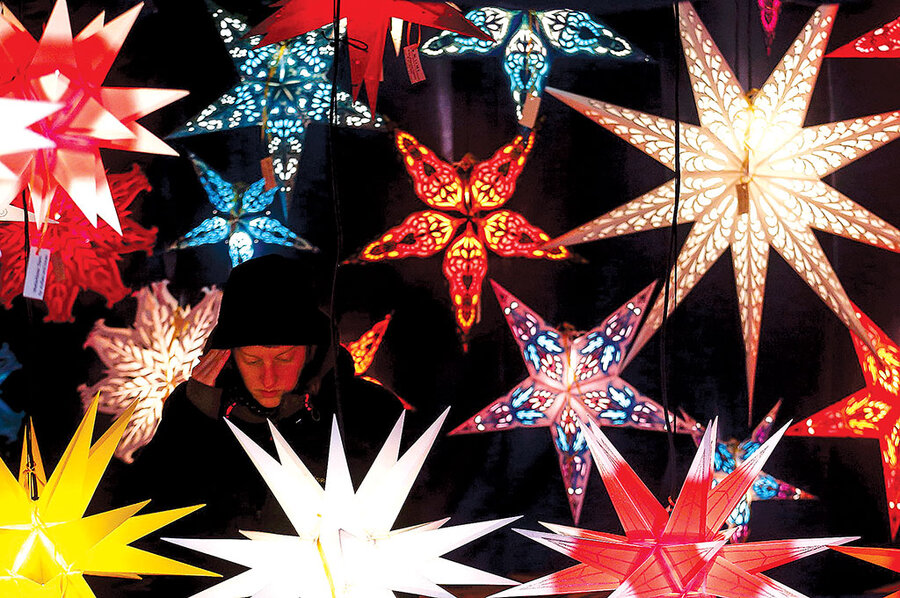Three generations, seven fishes
Nonna in the kitchen: Every burner, every inch of stove-top, and every counter is a fish zone. She soaks the baccalà (dried and salted cod) and pries open clams. She peels and deveins shrimp, fries up smelt and octopus, and breads and bakes calamari. She stuffs mushroom caps with crabmeat, and we, her extended family, devour her seven fishes on Christmas Eve. In this way, we abstain from eating meat, and she abstains from having a free minute to do anything other than shopping, preparing, cooking, and serving seven fish dishes.
Seven’s the number for Roman Catholics: seven sacraments, seven days of creation, seven hills surrounding Rome. The Feast of Seven Fishes for La Vigilia di Natale (Christmas Eve) to await the birth of Jesus is a tradition from southern Italy, where my family roots are: Sicily on my mother’s side and Calabria on my father’s – their coastlines abundant with fish and fishermen.
* * *
My great-grandmother in the kitchen a generation before: She prepares seven fish dishes plus a dozen loaves of freshly baked bread to share with friends and family. When her doctor comes to pick up his loaf, she hurries to change into a clean apron before she answers the door.
* * *
My mother in the kitchen a generation later: On Christmas Eve, she removes plastic-wrapped shrimp cocktail and clams garnished with packets of lemon juice. She takes a slab of baked fish swimming in a pool of ersatz butter from its plastic foam container, all prepared by an “Ah-mer-i-gan” supermarket. She refuses to be pressed into the Italian stereotype of being a good cook and enjoying it, too. She’s the first to unapologetically admit her meals are menza menza (so-so) at best.
* * *
I am my mother’s daughter in the kitchen – in Boston, San Francisco, Pittsburgh, and Brooklyn, New York. I am childless by choice until my husband and I have a surprise pregnancy. I begin to obsess over what ethnic culture I have to pass on to the next generation. A piece of Velveeta between two slices of bread for Christmas Eve dinner, perhaps?
When I remember how my grandmother labored in the kitchen, I feel guilty and have to admit there’s a time to soak salted fish, to shell clams and devein shrimp, a time for breading and baking, for frying, boiling, and stuffing. But new motherhood isn’t one of those times, for me. Instead it calls for a meal far less time-
consuming than hers yet more authentic than my Americanized mother’s. I want my seven fishes on Christmas Eve, and I want to eat them, too.
I don my grandmother’s apron for a little coraggio and surf for seven simple dishes to prepare. A trout bruschetta recipe reads, “cooked, cured, mixed, and spread.” Too many action verbs for me. Puttanesca panzarotti clocks in with nearly four hours to prepare and cook. Next. Any recipe with “all you have to do,” “make it easily in advance,” or “toss it in the oven and – voilà!” I click on.
Then Old World traditional gets New World practical: Seven dishes of fish is six too many. If all kinds swim in one sea, why not seven in one pot? I pull out an Italian cookbook and improvise a fish stew. The recipe calls for three kinds of fish, so I add four more to make a symbolic seven along with some other ingredients to give it my personal touch. I recruit my son to count each fish as I ceremoniously plop them into a pot of tomato sauce. Uno, due, tre, quattro, cinque, sei, sette: Zuppa dei sette pesci slam-dunked in sette minuti!
* * *
Three generations after Nonna: I imagine my sons, disposable incomes in their pockets, perhaps, when they’ve grown up, smartphones in their hand, looking up restaurants that serve or deliver seven fish dishes on Christmas Eve. An all-you-can-eat sushi bar? A catering company with an extensive menu of fish appetizers and entrees to order and pick up on Christmas Eve day?
Or maybe, just maybe, my sons are in the kitchen preparing that user-friendly zuppa of mine – fish, and seven of them.
For me.





